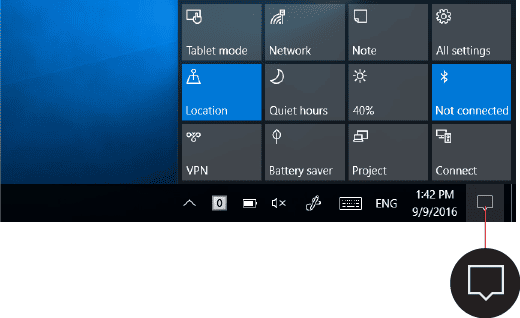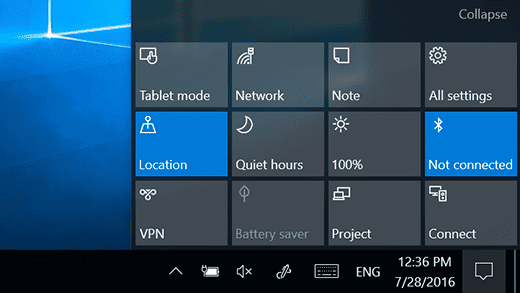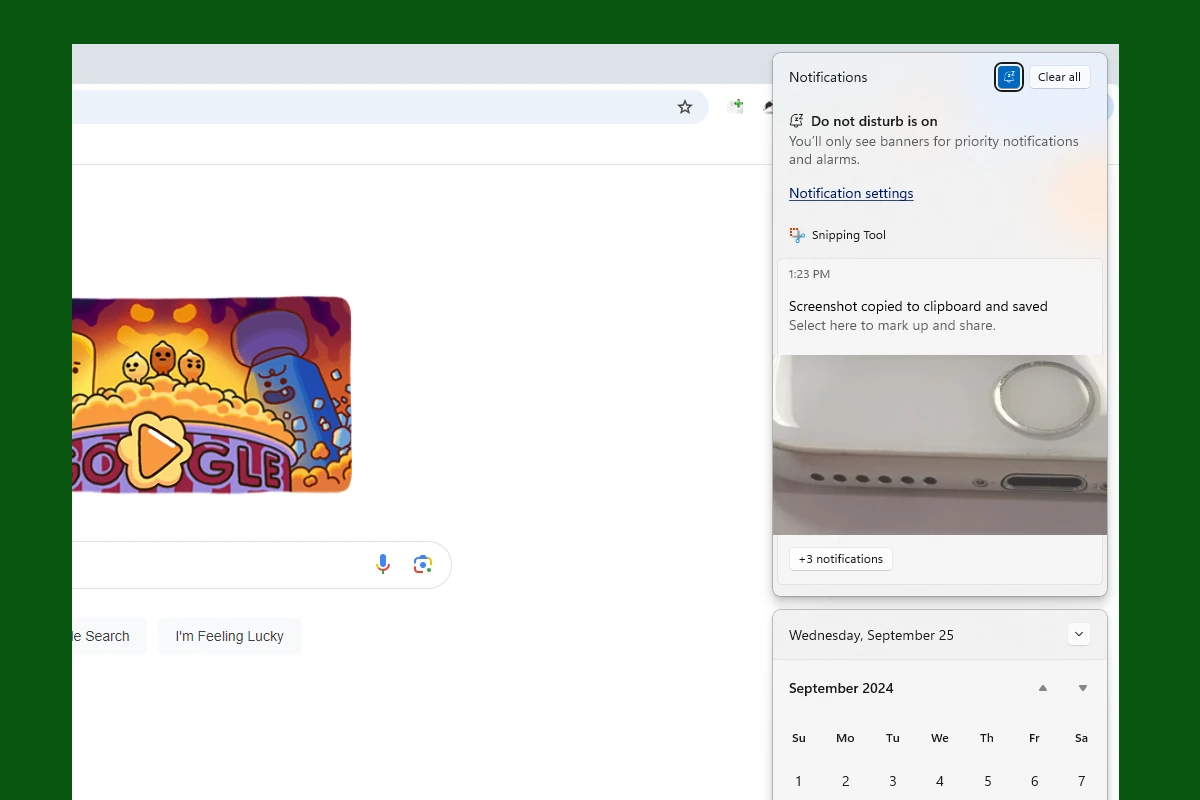Yes and No. Windows does keep a very short-term history of your notifications, accessible through the Notification Center (Win + N). However, this history is limited and automatically clears after a certain period or number of notifications. Alternatively you can click the “bell” symbol in the far right corner of the Taskbar. Unfortunately, beyond that there is no way to view a history of notifications because Windows does not log them. There are 3rd party applications you can purchase to log your notifications, but those are not built into Windows.
If you’re looking for a more comprehensive or long-term history, Windows doesn’t offer a built-in solution. However, there are a few workarounds:
- Check individual app settings: Some apps might retain their own notification history within their settings or preferences.
- Use third-party apps: Several third-party apps claim to offer notification history logging, but proceed with caution and do your research before installing any software.
- Dig into the Event Viewer: For certain system-level notifications, you may find some clues in the Windows Event Viewer, though it’s not a user-friendly way to track notifications.
In essence, while Windows provides a glimpse of recent notifications, it doesn’t have a robust built-in notification history feature. If tracking notifications is important to you, consider exploring third-party solutions or adjusting individual app settings.
Windows Notification History
Unfortunately, Windows lacks a built-in feature to directly view a complete history of notifications. However, depending on your needs, you can explore these options:
| Method | Details | Limitations |
|---|---|---|
| Action Center (Recent Notifications) | 1. Press Windows key + N or click the notification icon on the taskbar. 2. You’ll see a list of recent notifications with basic information. | Displays only past few notifications, limited details, disappears after a while. |
| Event Viewer (System Logs) | 1. Open Event Viewer (Start menu > Event Viewer). 2. Expand Applications and Services Logs > Microsoft > Windows > Windows Defender > Operational. 3. Look for “Notification” entries with details like title, content, and application. | Technical information, requires some IT knowledge, shows only Defender notifications. |
| Third-party Apps | 1. Download and install apps like Notificheer or Notification History Lite. 2. These apps capture and store all notifications, allowing you to filter and search through them. | Requires additional software, potential privacy concerns, may not capture all notifications. |
| Manually Record Screenshots or Text Snippets | 1. Take screenshots or copy/paste notification text when they appear. 2. Organize them in a folder or document for future reference. | Manual effort, time-consuming, can be messy depending on organization. |

Tips:
- Enable “Show notifications on the lock screen” for quick access to recent notifications, even when locked.
- Consider setting notification priorities to avoid clutter and focus on important ones.
- Be mindful of the limitations and potential risks of third-party apps.
Remember, while viewing a complete historical record isn’t readily available in Windows, these methods offer alternative ways to access and manage past notifications based on your specific needs and comfort with technical solutions.

Key Takeaways
- The notification center has evolved significantly from its inception in Windows to its current form in Windows 10 and 11.
- Windows 11 brought about major enhancements in the notification center, including improved user interface and integration with other system functions.
- Customization and user privacy have become focal points in the development of modern notification centers.
Introduction to Notification Centers
Notification centers have become an integral part of modern operating systems, offering a centralized hub for managing alerts and updates. Their journey, particularly in Windows operating systems, showcases a blend of technological innovation and user-centric design evolution.
Evolution from Windows 10 to Windows 11
The transition from Windows 10 to Windows 11 marked a significant leap in the functionality and aesthetics of the notification center. Windows 10 laid the groundwork with a basic, yet functional approach, while Windows 11 introduced a more refined and user-friendly experience.
Notification Center in Windows 10: A Retrospective
Windows 10 was a pivotal point in the evolution of the notification center, introducing a more coherent and interactive system.
The Birth of the Action Center
The introduction of the Action Center in Windows 10 was a game-changer. It not only provided notifications but also quick action buttons for easy access to frequently used settings.
User Experience in Windows 10
- Centralized notifications
- Quick access to settings
- Integration with Cortana for intelligent alerts
Discover the History of Windows 10’s Notification Center:
View past notifications in Windows 10? (2 Solutions!!) – A useful video on YouTube that delves into the workings of the notification center in Windows 10.

Windows 11: Enhancements and Changes
With Windows 11, the notification center saw substantial improvements, both in functionality and design.
A Refined Interface
Windows 11’s notification center boasts a cleaner, more intuitive interface, making it easier for users to interact with their notifications.
Advanced Integration
Integration with new features such as Focus Assist and direct links to settings provides a more seamless experience.
User Experience in Windows 11
- Enhanced visual design
- Improved integration with system settings
- Greater customization options
Learn More About Windows 11’s Notification Center:
How to Manage Notifications in Windows 11 – This YouTube video offers a comprehensive guide on managing notifications in Windows 11.
Technical Aspects of Notification Centers
Understanding the technicalities behind notification centers provides insight into their complexity and utility.
Behind the Scenes
Notification centers involve complex coding and integration with various system components to deliver timely and relevant notifications.
Importance in Daily Computing
- Keeps users informed about important updates
- Helps manage workflow and productivity
- Enhances overall user experience with the operating system
Customization and User Control
Modern notification centers offer significant customization options, allowing users to tailor their experience according to their preferences.
Setting Preferences
Users can choose which apps can send notifications, how they appear, and when they are allowed to interrupt.
Focus on User Privacy
With growing concerns over privacy, modern notification centers have incorporated features to safeguard user information.
Security and Privacy Concerns
The evolution of notification centers also brings forward questions about security and privacy.
Potential Risks
- Unauthorized access to personal information
- Over-reliance on notifications leading to distractions
Mitigating Risks
Developers are continuously working to enhance the security features of notification centers to protect user data.

User Experience: How Notification Centers Impact Daily Use
Notification centers play a crucial role in the modern digital experience. They not only inform but also shape our interaction with technology.
Impact on Daily Computing
- Efficiency: Quick access to important alerts improves productivity.
- Convenience: Centralized notifications simplify monitoring of various applications.
- Customizability: Users can personalize notifications to match their preferences and needs.
Real-World Applications
- Professional Use: In work environments, notification centers help manage emails, appointments, and reminders efficiently.
- Personal Use: For personal devices, they provide updates on social media, news, and more, keeping users connected and informed.
Enhancing User Experience
- Design: Visually appealing and user-friendly interfaces increase engagement.
- Integration: Seamless integration with other system functionalities enhances overall utility.
Technical Insights
The backbone of the Notification Center lies in its sophisticated technical design.
System Integration
- OS Compatibility: Ensures smooth functioning across different versions of operating systems.
- App Communication: Allows various applications to send notifications through a unified system.
Security Features
- Data Protection: Implements measures to safeguard sensitive information displayed in notifications.
- Privacy Controls: Offers users control over what notifications to receive and how they are displayed.
Table: Notification Center Features Over Different Windows Versions
| Windows Version | Key Features | User Interface | Customization |
|---|---|---|---|
| Windows 10 | Action Center, Cortana Integration | Basic, Functional | Limited |
| Windows 11 | Enhanced UI, Focus Assist | Refined, Intuitive | Extensive |
Further Exploration of Windows 11 Notification Center:
Learn How to Use the Notification Center and Quick Settings in Windows 11 – A detailed tutorial video on YouTube about the Notification Center in Windows 11.
Frequently Asked Questions
What was the first version of Windows to introduce a notification center?
The concept of a notification center was first introduced in Windows 10, with the development of the Action Center.
How has the notification center evolved in Windows 11?
In Windows 11, the notification center has been enhanced with a more intuitive interface, improved customization options, and better integration with system settings.
Can users customize the notification center in Windows 10 and 11?
Yes, both Windows 10 and 11 offer various customization options for the notification center, allowing users to control the type of notifications they receive and how they are displayed.
Are there any privacy concerns with notification centers?
Yes, privacy concerns exist, especially regarding the display of personal information in notifications. Modern operating systems include features to manage these concerns effectively.







